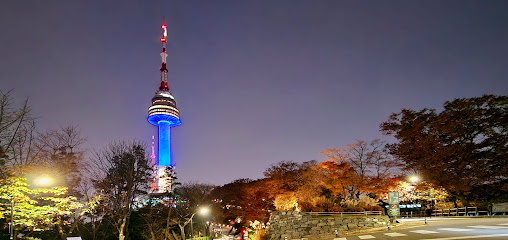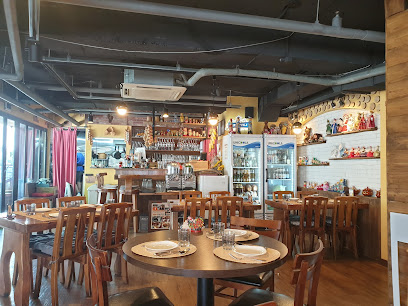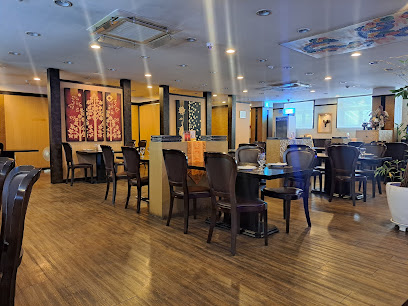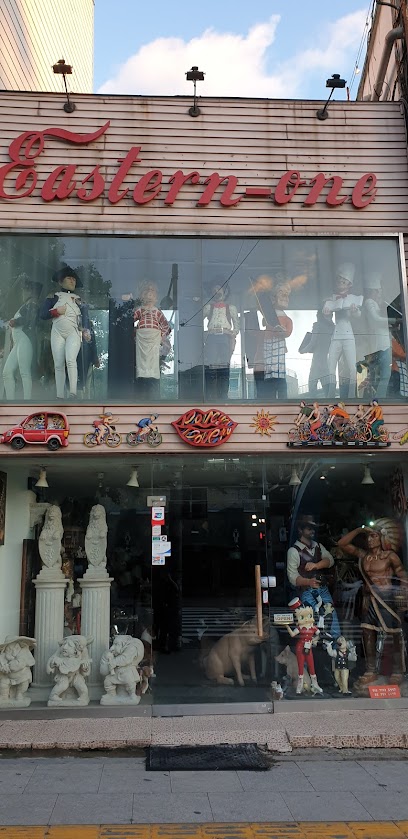
Itaewon: Seoul's Melting Pot of Cultures and Cuisines
Discover Itaewon: Seoul's vibrant melting pot, offering a blend of global cultures, diverse cuisines, lively nightlife, and rich historical landmarks.
Nestled in the heart of Seoul, Itaewon is a vibrant, multicultural neighborhood that offers an eclectic mix of cultures, cuisines, and experiences. Known for its diverse population, Itaewon is a place where you can find people from all walks of life, making it a melting pot of global cultures. The streets are lined with international restaurants, trendy cafes, and bustling markets, offering a taste of the world in one compact area. Itaewon is also famous for its nightlife, with a variety of bars, clubs, and live music venues that cater to all tastes. Whether you're looking for a quiet evening with a glass of wine or a lively night out dancing, Itaewon has something for everyone. The neighborhood is particularly popular among expatriates and tourists, making it an ideal destination for those looking to meet new people and experience different cultures. Aside from its culinary and nightlife offerings, Itaewon is home to several historical and cultural landmarks. The War Memorial of Korea and the Itaewon Antique Furniture Street provide a glimpse into Korea's rich history and heritage. Additionally, Itaewon is conveniently located near Namsan Mountain, offering stunning views of the city and a peaceful retreat from the urban hustle and bustle. A visit to Itaewon promises a unique and enriching experience, blending the old with the new and the local with the global.
Local tips in Itaewon
- Visit on weekends for the best nightlife experience.
- Wear comfortable shoes as the area is best explored on foot.
- Try the international cuisine, especially the Middle Eastern and Indian restaurants.
- Check out the local markets for unique souvenirs.
- Visit the War Memorial of Korea for a historical perspective.
- Head to Namsan Mountain for scenic views and a peaceful retreat.
Itaewon: Seoul's Melting Pot of Cultures and Cuisines
Nestled in the heart of Seoul, Itaewon is a vibrant, multicultural neighborhood that offers an eclectic mix of cultures, cuisines, and experiences. Known for its diverse population, Itaewon is a place where you can find people from all walks of life, making it a melting pot of global cultures. The streets are lined with international restaurants, trendy cafes, and bustling markets, offering a taste of the world in one compact area. Itaewon is also famous for its nightlife, with a variety of bars, clubs, and live music venues that cater to all tastes. Whether you're looking for a quiet evening with a glass of wine or a lively night out dancing, Itaewon has something for everyone. The neighborhood is particularly popular among expatriates and tourists, making it an ideal destination for those looking to meet new people and experience different cultures. Aside from its culinary and nightlife offerings, Itaewon is home to several historical and cultural landmarks. The War Memorial of Korea and the Itaewon Antique Furniture Street provide a glimpse into Korea's rich history and heritage. Additionally, Itaewon is conveniently located near Namsan Mountain, offering stunning views of the city and a peaceful retreat from the urban hustle and bustle. A visit to Itaewon promises a unique and enriching experience, blending the old with the new and the local with the global.
Iconic landmarks you can’t miss
Gyeongnidan-gil
Explore Gyeongnidan-gil, a vibrant street in Yongsan-gu, Seoul, offering a diverse mix of global cuisines, unique shops, and an energetic nightlife.

Itaewon Antique Furniture Street
Explore Itaewon Antique Furniture Street in Seoul, a vibrant hub of unique vintage treasures and rich cultural heritage waiting to be discovered.

Itaewon Bugundang Historical Park
Discover the lush greenery and historical charm of Itaewon Bugundang Historical Park, a serene escape in the heart of Seoul's vibrant Yongsan district.

Itaewon Special Tourist Zone Organization
Discover the vibrant culture, diverse cuisine, and lively nightlife of Itaewon, a must-visit destination in Seoul for every traveler.

October 29 Itaewon Tragedy Memorial Alley
Explore the Itaewon Tragedy Memorial Alley, a poignant tribute to resilience and remembrance in the heart of Seoul's vibrant Itaewon district.

Usadan-gil
Experience the vibrant culture and culinary delights of Usadan-gil, a charming street in Yongsan-gu, Seoul, perfect for exploring and relaxing.

Statue of Peace
Explore the Statue of Peace in Yongsan-gu, Seoul: a poignant memorial honoring the resilience of comfort women and a vital part of Korea’s historical narrative.

Bugundang Shrine
Discover the serene beauty and rich history of Bugundang Shrine in Seoul, a captivating historical landmark that reflects Korea's cultural heritage.

Itaewon Bugundang Historical Park Observatory
Discover breathtaking views of Seoul's skyline and rich cultural heritage at the Itaewon Bugundang Historical Park Observatory, a hidden gem in the heart of the city.

Ryu Gwan-sun Monument
Explore the Ryu Gwan-sun Monument in Seoul: a powerful tribute to resistance and freedom in Korea’s history, set in a tranquil park.

Unmissable attractions to see
Namsan Mountain Park
Explore the breathtaking views, lush trails, and rich history of Namsan Mountain Park, a serene escape in the bustling heart of Seoul.

Gyeongnidan-gil
Explore Gyeongnidan-gil, a vibrant street in Yongsan-gu, Seoul, known for its eclectic mix of cafes, restaurants, and vibrant nightlife.

Namsan Outdoor Botanical Garden
Discover tranquility at Namsan Outdoor Botanical Garden, Seoul's urban oasis filled with diverse flora and peaceful walking paths for a perfect nature escape.

Itaewon Antique Furniture Street
Explore Itaewon Antique Furniture Street for unique vintage treasures and a glimpse into Korea's rich cultural heritage.

Itaewon Bugundang Historical Park
Discover the tranquility of Itaewon Bugundang Historical Park, a lush green retreat steeped in history, perfect for relaxation and cultural exploration in Seoul.

Itaewon Special Tourist Zone Organization
Explore Itaewon, Seoul's vibrant cultural hub, where diverse cuisines, shopping, and nightlife converge in a unique travel experience.

Yongsan Haebangchon Village
Explore the vibrant Yongsan Haebangchon Village, where eclectic cafes, local art, and a rich cultural experience await in the heart of Seoul.

Essential places to dine
Linus BBQ
Experience the essence of Southern barbecue at Linus BBQ in Seoul—where every bite tells a story.

مطعم البتراء Petra Restaurant
Experience authentic halal cuisine at Petra Restaurant in Yongsan-gu, Seoul - where tradition meets modern culinary excellence.

Braai Republic
Discover the rich flavors of authentic South African cuisine at Braai Republic in Seoul - where every meal is a celebration.

Maple Tree House
Experience authentic Korean BBQ at Maple Tree House in Yongsan-gu, where premium meats meet vibrant flavors in a lively atmosphere.

Troika
Experience authentic Russian cuisine at Troika in Seoul's vibrant Itaewon district—where tradition meets flavor in every dish.

Kervan Turkish Restaurant Halal ITAEWON
Experience authentic Turkish cuisine at Kervan Restaurant in Itaewon – where every meal is a delightful journey through flavors.

Buddha's Belly Itaewon
Experience authentic Thai cuisine at Buddha's Belly Itaewon—where every dish tells a story of flavor and tradition.

Wang Thai
Experience authentic Thai cuisine at Wang Thai in Itaewon – where rich flavors meet warm hospitality in the heart of Seoul.

Itaewon Restaurant Cote Jardin
Experience exquisite French brunch at Cote Jardin, an elegant restaurant in Itaewon that delights with every bite.

HojiBobo Restaurant | Itaewon Seoul
Experience the best of Uzbek cuisine and succulent steaks at HojiBobo Restaurant in Itaewon, Seoul - where every bite tells a story.

Markets, malls and hidden boutiques
Itaewon Market
Discover the bustling Itaewon Market, where diverse cultures, delicious street food, and unique shopping experiences await every visitor.

INTERNATIONAL UNDER GROUND MARKET
Explore the International Underground Market in Yongsan-gu, Seoul, for a unique blend of fashion, culture, and local craftsmanship.

Eastern one
Explore Eastern One, a charming figurine shop in Itaewon, where art and culture blend to create unique collectibles and souvenirs.

Korean Souvenir
Discover unique Korean keepsakes at Korean Souvenir, where every item is a piece of culture waiting to be cherished.

Warpedshop
Explore Warpedshop in Yongsan-gu, Seoul - your destination for unique home goods and stylish decor that embody Korean creativity.

무지개GIFTSHOP
Discover unique gifts and local treasures at 무지개GIFTSHOP in the heart of Itaewon, Seoul, where every item tells a story.

PACIFIC SHOPPING
Explore the vibrant Pacific Shopping in Itaewon-dong for unique military souvenirs and memorable gifts reflecting Korea's rich heritage.

옥탑방
Explore the heart of Seoul with unique gifts and souvenirs at 옥탑방, a charming gift shop in Yongsan-gu offering local craftsmanship and creativity.

Itaewon Shop
Explore the vibrant Itaewon Shop in Seoul for unique clothing styles that reflect the diverse culture of this iconic neighborhood.

UNION SHOP
Discover the beauty of traditional Hanbok at UNION SHOP in Seoul's Yongsan-gu, where culture and fashion blend seamlessly.

Essential bars & hidden hideouts
Fountain
Experience the vibrant nightlife at Fountain, a multi-level bar in Itaewon, offering a diverse drink menu and energetic atmosphere.

Prost Pub & Grill, Seoul
Discover the lively Prost Pub & Grill in Itaewon, Seoul, where craft beers and delicious grills meet a vibrant nightlife atmosphere.

Southside Parlor
Experience the best of American cocktails and vibrant nightlife at Southside Parlor, a top cocktail bar in Seoul’s Yongsan-gu.

Ugly Society
Experience the vibrant nightlife of Seoul at Ugly Society, a cocktail bar known for its innovative drinks and eclectic decor in the heart of Iteawon.

Blacklist
Discover Blacklist, a premier cocktail bar and restaurant in Itaewon, Seoul, known for its exquisite drinks and gourmet dishes in a chic atmosphere.

The Bulldog Pub
Discover the lively atmosphere and friendly service of The Bulldog Pub, a must-visit bar in Seoul's vibrant Itaewon district.

The Finest
Explore the sophisticated charm of The Finest wine bar in Yongsan, Seoul, where exquisite wines meet a vibrant nightlife experience.

King Pub
Discover the vibrant atmosphere of King Pub, a must-visit sports bar in Yongsan-gu, Seoul, blending local culture with lively nightlife.

Flower Gin
Experience the enchanting blend of floral beauty and innovative cocktails at Flower Gin, a must-visit bar in Yongsan-gu, Seoul.

Scrooge Pub
Discover Scrooge Pub, a lively sports bar in Seoul's Itaewon, offering great drinks, delicious pub food, and a vibrant atmosphere for all.

Local Phrases
-
- Hello안녕하세요
[an-nyeong-ha-se-yo] - Goodbye안녕히 가세요
[an-nyeong-hi ga-se-yo] - Yes네
[ne] - No아니요
[a-ni-yo] - Please/You're welcome부탁합니다/천만에요
[bu-tak-ham-ni-da/cheon-man-e-yo] - Thank you감사합니다
[gam-sa-ham-ni-da] - Excuse me/Sorry죄송합니다
[joe-song-ham-ni-da] - How are you?어떻게 지내세요?
[eo-tteo-ke ji-nae-se-yo] - Fine. And you?잘 지내요. 그리고 당신은?
[jal ji-nae-yo. geu-ri-go dang-si-neun?] - Do you speak English?영어 할 수 있어요?
[yeong-eo hal su iss-eo-yo] - I don't understand이해하지 못해요
[i-hae-ha-ji mot-hae-yo]
- Hello안녕하세요
-
- I'd like to see the menu, please메뉴를 보고 싶어요
[me-nyu-reul bo-go ship-eo-yo] - I don't eat meat고기를 먹지 않아요
[go-gi-reul meok-ji anh-a-yo] - Cheers!건배!
[geon-bae!] - I would like to pay, please계산을 해 주세요
[gye-san-eul hae ju-se-yo]
- I'd like to see the menu, please메뉴를 보고 싶어요
-
- Help!도와주세요!
[do-wa-ju-se-yo!] - Go away!가라!
[ga-ra!] - Call the Police!경찰을 부르세요!
[gyeong-chal-eul bu-reu-se-yo!] - Call a doctor!의사를 불러주세요!
[ui-sa-reul bulleo-ju-se-yo!] - I'm lost길을 잃었어요
[gil-eul ilh-eoss-eo-yo] - I'm ill아파요
[a-pa-yo]
- Help!도와주세요!
-
- I'd like to buy...구매하고 싶어요...
[gu-mae-ha-go ship-eo-yo...] - I'm just looking그냥 둘러보고 있어요
[geu-nyang dul-leo-bo-go iss-eo-yo] - How much is it?얼마에요?
[eol-ma-e-yo?] - That's too expensive너무 비싸요
[neo-mu bi-ssa-yo] - Can you lower the price?가격을 깎아 주실 수 있어요?
[ga-geuk-eul kka-ga ju-shil su iss-eo-yo?]
- I'd like to buy...구매하고 싶어요...
-
- What time is it?지금 몇 시에요?
[ji-geum myeot si-e-yo?] - It's one o'clock한 시에요
[han si-e-yo] - Half past (10)십 시 반
[sip si ban] - Morning아침
[a-chim] - Afternoon오후
[o-hu] - Evening저녁
[jeo-nyeok] - Yesterday어제
[eo-je] - Today오늘
[o-neul] - Tomorrow내일
[nae-il] - 1일
[il] - 2이
[i] - 3삼
[sam] - 4사
[sa] - 5오
[o] - 6육
[yuk] - 7칠
[chil] - 8팔
[pal] - 9구
[gu] - 10십
[sip]
- What time is it?지금 몇 시에요?
-
- Where's a/the...?어디에...이에요?
[eo-di-e...i-e-yo?] - What's the address?주소가 뭐에요?
[ju-so-ga mwo-e-yo?] - Can you show me (on the map)?지도로 보여주세요?
[ji-do-ro bo-yeo-ju-se-yo?] - When's the next (bus)?다음 (버스) 언제에요?
[da-eum (beo-seu) eon-je-e-yo?] - A ticket (to ....)표 (....로)
[pyo (....ro)]
- Where's a/the...?어디에...이에요?
History of Itaewon
-
Itaewon's history can be traced back to the Joseon Dynasty when it was primarily a farming village. Its name, meaning 'the place where water flows,' reflects its geography. The area remained relatively quiet until the late 19th century when it began to develop due to its proximity to the newly established Hanseong (Seoul) and the influx of foreign trade.
-
The Korean War (1950-1953) marked a significant turning point for Itaewon. Following the war, the presence of American military personnel established Itaewon as an international district. The influx of soldiers led to the growth of bars, restaurants, and shops catering to foreign tastes, transforming the neighborhood into a vibrant cultural melting pot.
-
During the 1970s and 1980s, Itaewon underwent rapid urbanization. The government promoted the area as a tourist destination, leading to an increase in businesses catering to both locals and foreigners. This period saw the establishment of numerous international restaurants and shops, making Itaewon a hub for expatriates and tourists.
-
In the 2000s, Itaewon experienced significant gentrification, with the construction of upscale condominiums and boutique shops. As the area diversified, it became known for its vibrant LGBTQ+ scene and multicultural atmosphere, attracting a younger demographic and artists. Events such as the Itaewon Global Village Festival further celebrated this diversity.
-
The COVID-19 pandemic in 2020 posed significant challenges for Itaewon, impacting its bustling nightlife and tourism. However, the neighborhood demonstrated resilience, with businesses adapting to new health protocols and the rise of outdoor dining. As South Korea gradually reopened, Itaewon has been working to reclaim its status as a lively cultural and social hub.
Itaewon Essentials
-
Itaewon is easily accessible from various neighborhoods in Seoul. The nearest subway station is Itaewon Station (Line 6), which connects to major lines across the city. From popular areas like Myeongdong or Hongdae, you can take Line 4 to Dongdaemun, then transfer to Line 6. Alternatively, taxis and ride-sharing services are widely available, and the journey from downtown areas typically takes 10-20 minutes, depending on traffic.
-
Itaewon is pedestrian-friendly, with many attractions within walking distance. The subway system is efficient, with Itaewon Station being the main hub. Buses also serve the area, connecting it to other neighborhoods. For a more local experience, consider renting a bicycle through Seoul's bike-sharing program, 'Seoul Bike,' which has stations throughout the area. Taxis are also readily available for longer distances.
-
Itaewon is generally a safe area for tourists, but it's wise to remain vigilant, especially at night. While violent crime is rare, petty theft can occur, particularly in crowded places. Areas like the alleyways around the main street can be less safe late at night. It is advisable to avoid secluded spots and keep personal belongings secure.
-
In case of emergency, dial 112 for police assistance or 119 for fire and medical emergencies. English-speaking operators may not always be available, so having a local contact or knowing some Korean phrases can be helpful. For minor health issues, visit a local pharmacy or the nearest hospital, such as the Seoul National University Hospital.
-
Fashion: Do dress appropriately, especially in religious sites; avoid overly revealing clothing. Religion: Do respect customs, especially in mosques; remove shoes before entering. Public Transport: Do stand to the right on escalators and give up your seat to the elderly; don't eat or drink on public transport. Greetings: Do greet with a slight bow or handshake; don't use overly familiar terms unless invited. Eating & Drinking: Do try local street food and share meals; don't waste food, as it is considered disrespectful.
-
To experience Itaewon like a local, explore the backstreets for hidden gems like quaint cafes and boutique shops. Visit the Itaewon Antique Furniture Street for unique finds. Participate in local events or festivals, particularly during the Itaewon Global Village Festival. Engage with the vibrant expatriate community, and don't hesitate to ask locals for recommendations on off-the-beaten-path eateries or entertainment.
Trending Landmarks in Itaewon
Nearby Cities to Itaewon
-
Things To Do in Incheon
-
Things To Do in Suwon
-
Things To Do in Chuncheon
-
Things To Do in Daejeon
-
Things To Do in Jeonju
-
Things To Do in Andong
-
Things To Do in Daegu
-
Things To Do in Pohang
-
Things To Do in Gwangju
-
Things To Do in Gyeongju
-
Things To Do in Suncheon
-
Things To Do in Ulsan
-
Things To Do in Mokpo
-
Things To Do in Busan
-
Things To Do in Jeju City











